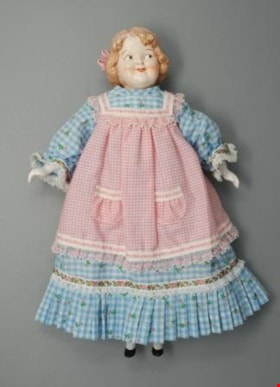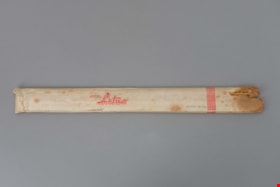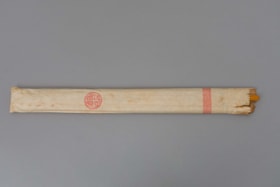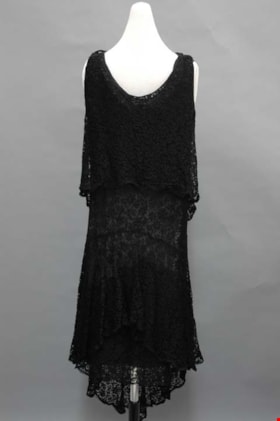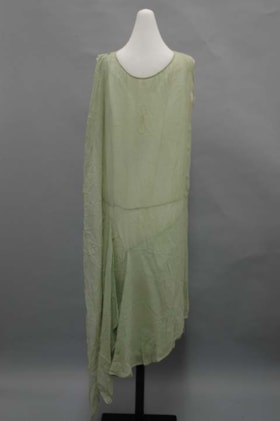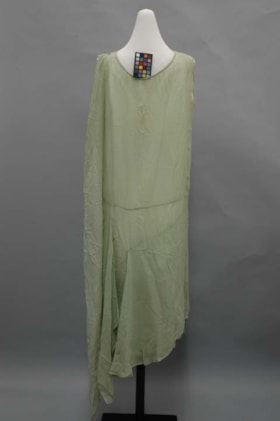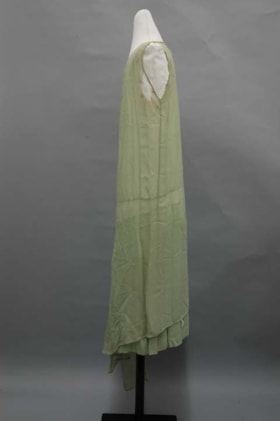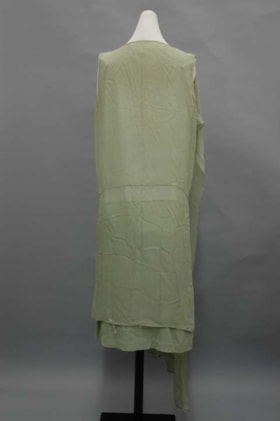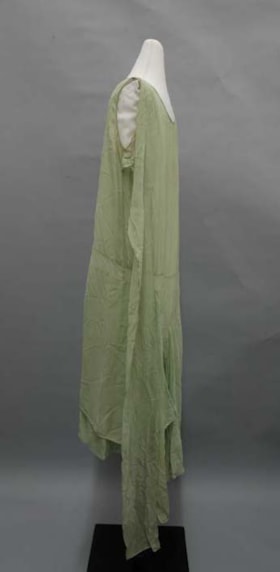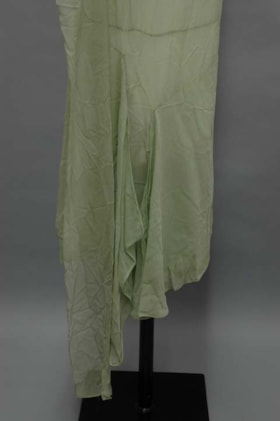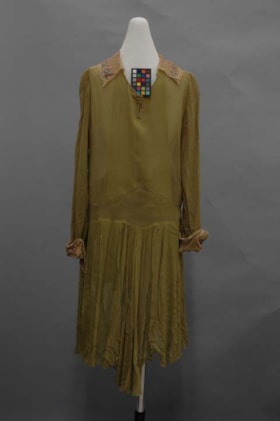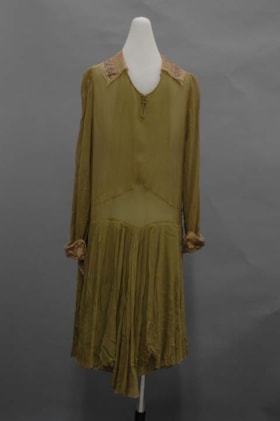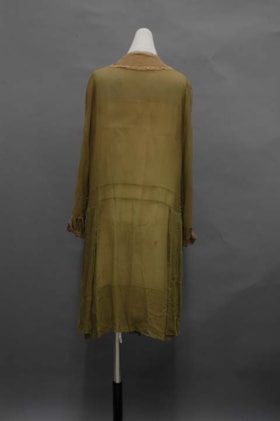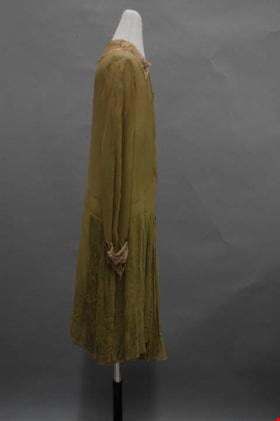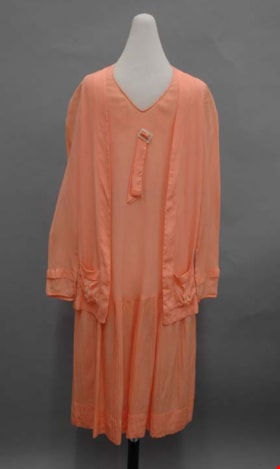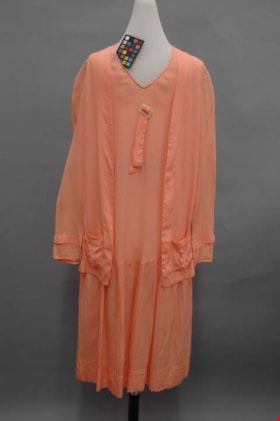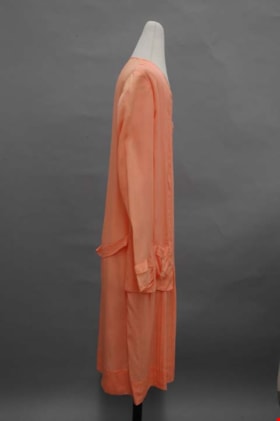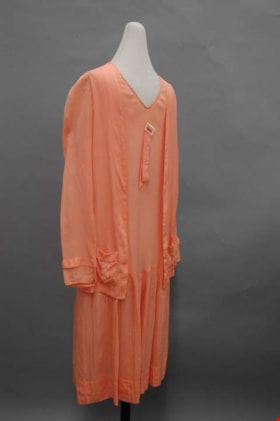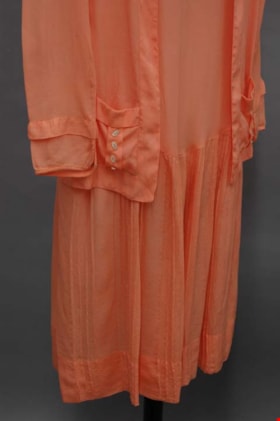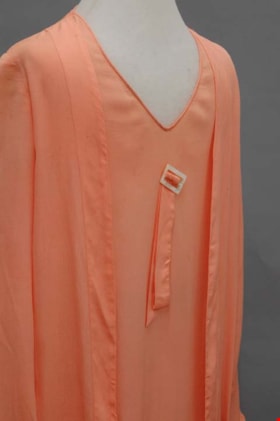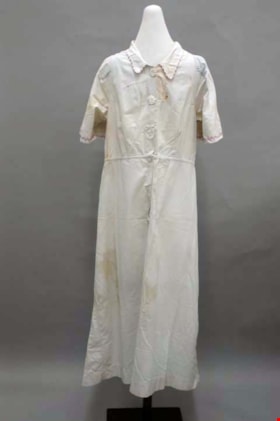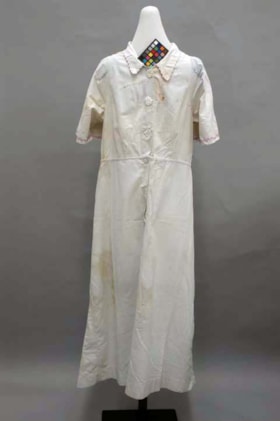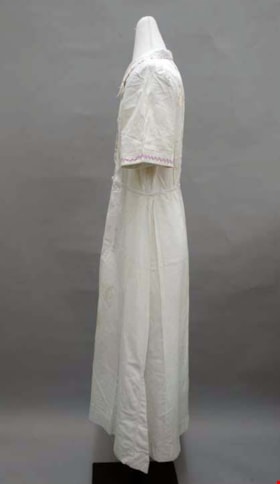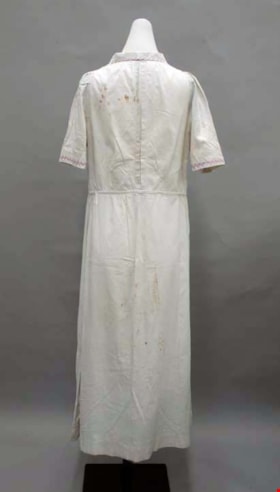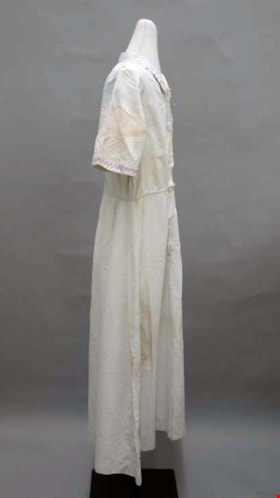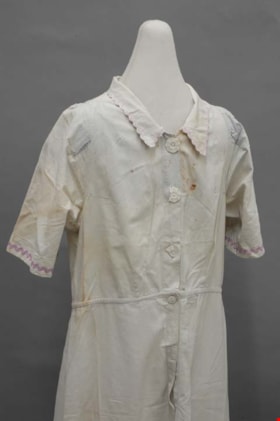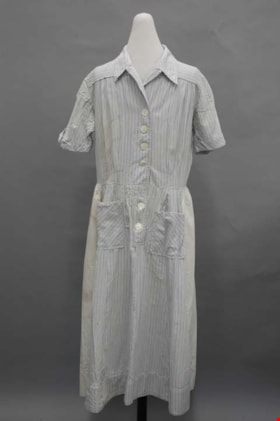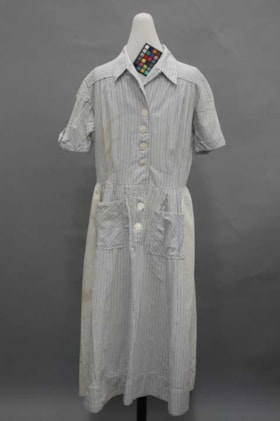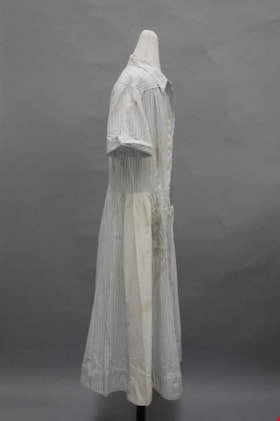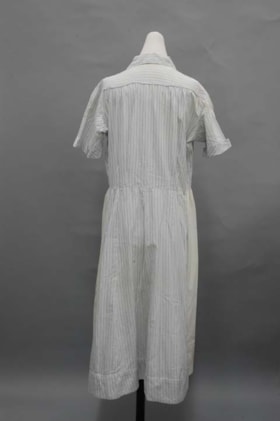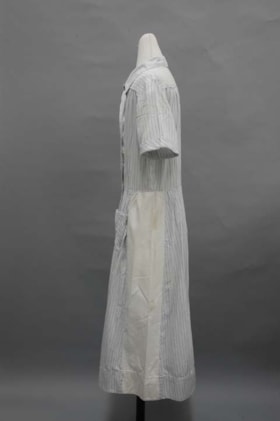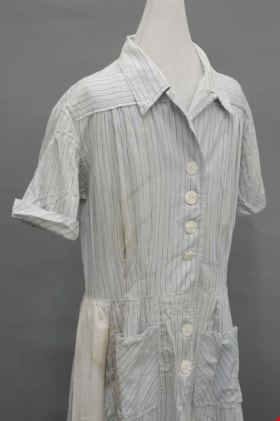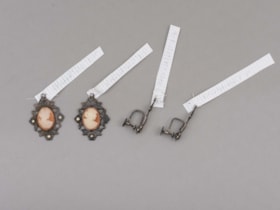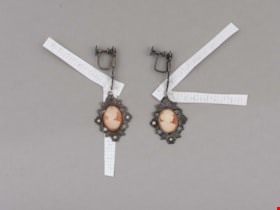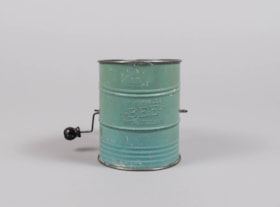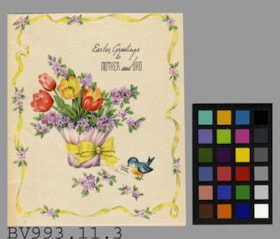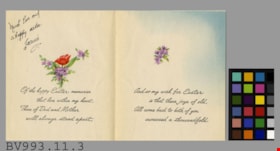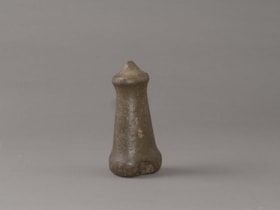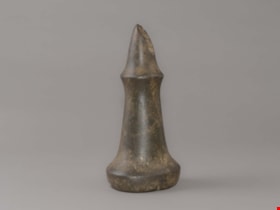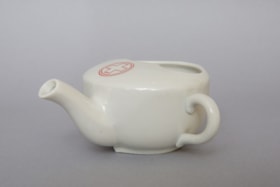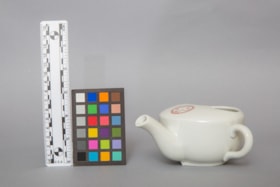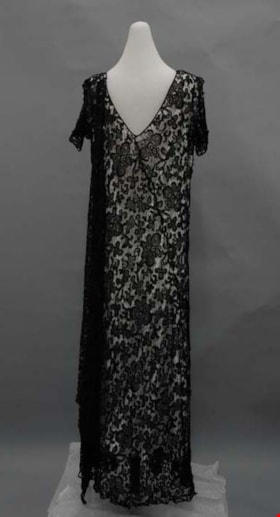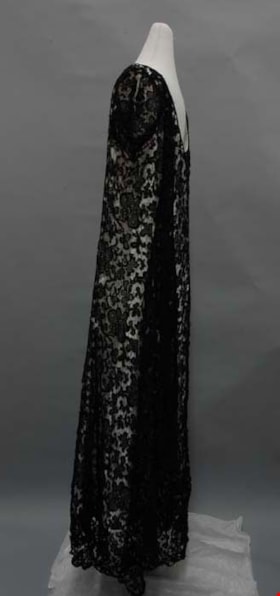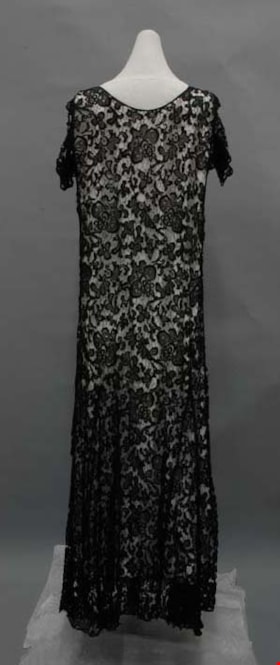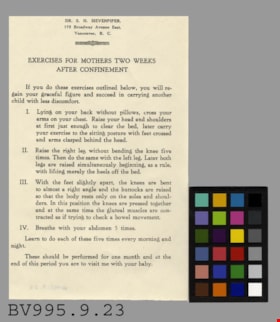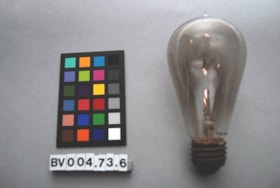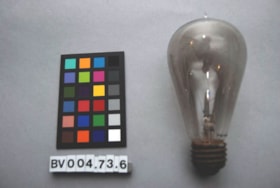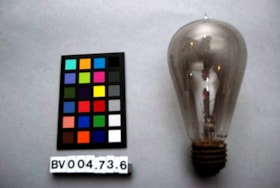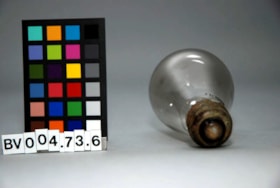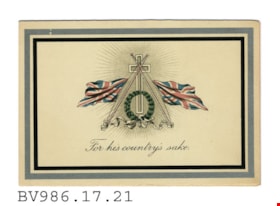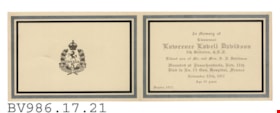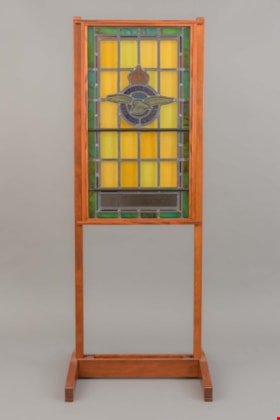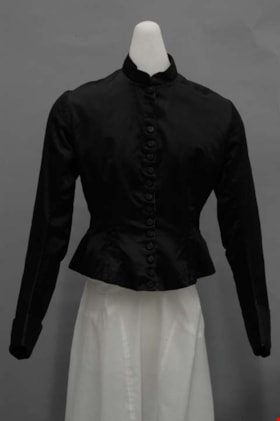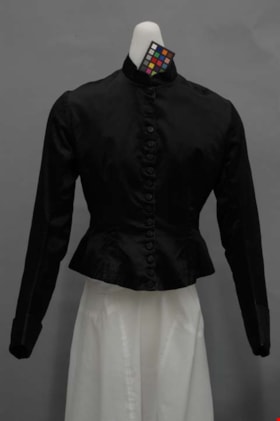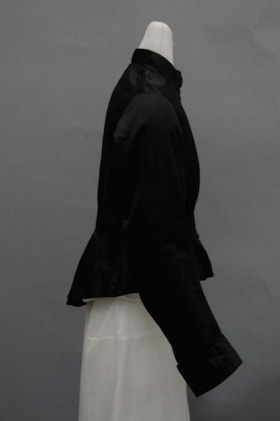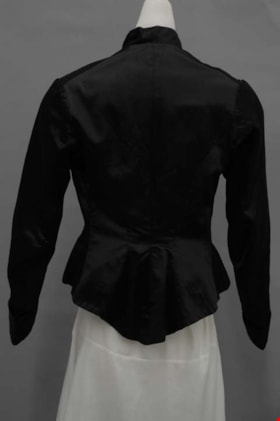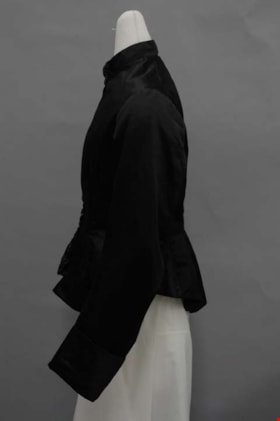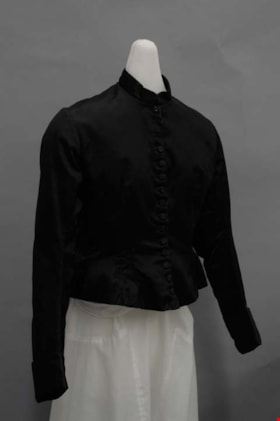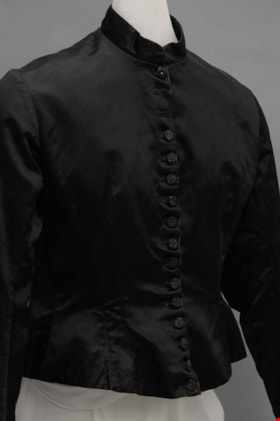Narrow Results By
Subject
- Advertising Medium - Signs and Signboards 1
- Archeological Specimen 31
- Armament 16
- Clothing 23
- Clothing - Costumes 23
- Communication Artifacts 1
- Container 4
- Container - Baskets 3
- Documentary Artifacts 16
- Documentary Artifacts - Booklets 4
- Documentary Artifacts - Cards 3
- Documentary Artifacts - Leaflets 1
Person / Organization
- Bateman, Mary Dale 1
- Bayntun, Charmaine "Sherrie" Yanko 2
- Bradley, William Ernest "Bill" 1
- British Columbia Electric Railway Company 1
- Descoteau, Norah Irene Byrne 1
- Helen's Childrens Wear 4
- Hill, Louis Claude "Claude" 31
- Imperial Order Daughters of the Empire 1
- Levins, Catherine Mary Corner 1
- Peers, Robert Claude Kenrick "Bob" 1
- Yanko Family 2
- Yanko, John Ivan 1
china doll
https://search.heritageburnaby.ca/link/museumartifact85780
- Repository
- Burnaby Village Museum
- Accession Code
- BV016.10.1
- Description
- This doll has a china head, hands and feet with fabric body. The neck collar has been broken in the past and there is a crack in the neck of the doll. the dolls head is roughly 7.5 cm in diameter. The glaze is in flesh tones with brown hair and a pink ribbon in the hair. The glaze is worn on the proper left cheek and at the back of the head. The arms and hands and shins and shoes are porcelain. The costume is a pink gingham over skirt on top of a blue gingham ankle length skirt. A knitted blue cape covers both. The doll is also wearing a slip and pantaloons.
- Object History
- Doll named "Lily" who belonged to Muriel (nee McLennan) Allinger. Muriel was born to William and Margaret McLennan in 1915 in BC. The family moved to Capitol Hill in 1919 and the doll was given as a Christmas present the year before. The china head was purchased at Miller and Coe on Hastings Street, in Vancouver in 1918. Muriel's mother made the first body and the first clothing.
- Category
- 9. Recreational Artifacts
- Classification
- Toys
- Object Term
- Doll
Images
chopstick
https://search.heritageburnaby.ca/link/museumartifact39973
- Repository
- Burnaby Village Museum
- Accession Code
- BV999.28.12
- Description
- Chopsticks, wooden; four; with paper bag, white with red "Hotel Lotus" and figures, and border
- Object History
- Donor inherited object from her mother and grandmother, ca. 1994. The Hotel Lotus was located in Vancouver at the corner of Pender and Abbott Streets. There was a restaurant located there in the 1950's & 60's called "Lotus Gardens" that featured Chinese and Western cuisine.
- Category
- 04.Tools & Equipment for Materials
- Classification
- Food Service T&E - - Eating & Drinking Utensils
- Object Term
- Chopsticks
- Subjects
- Persons - Chinese Canadians
Images
dress
https://search.heritageburnaby.ca/link/museumartifact27013
- Repository
- Burnaby Village Museum
- Accession Code
- HV974.69.8
- Description
- Evening dress, c.1929. Black rayon lace with cotton organdy slip. Sleeveless, flounced bodice and skirt. Knee length, dips to a longer hemline in the back. The dress is cut in the flapper style, but with 1930s style flounces. It is entirely made out of black rayon machine lace, with an organdy slip underneath. Hanging from the neckline there is a lace flounce with scalloped edge, overtop of the main lace dress. It hangs over the chest area in the front; at the back, it is tacked onto the dress underneath and comes down in a V shape. At a dropped waist height, where the V shape ends, the skirt of the main dress is another flounce. It ends at knee height in the front, and scoops down to calf length in the back. The slip attaches at the shoulders with a small strap that wraps around the shoulder at its seam and snaps back onto itself. At the bottom, there is a layer of lace sewn on to it that hangs a few inches past the slip hem. It comes up higher at the front, in a triangle shape.
- Object History
- Belonged to donor's mother, in West Vancouver.
- Subjects
- Clothing
- Clothing - Costumes
Images
dress
https://search.heritageburnaby.ca/link/museumartifact27016
- Repository
- Burnaby Village Museum
- Accession Code
- HV974.69.11
- Description
- Dress, c.1925-1929. Green silk chiffon. Sleeveless, straight cut, round neckline, scarf attached at right shoulder, dropped waist with skirt flounces, knee length. At each shoulder, there are five pin tucks, and at the right front shoulder there is a wide scarf as long as the dress that could be worn in a number of ways. At the dropped waist there is some very slight gathering in the bodice. The skirt has a plain inner layer and an outer layer that attaches to the back a few inches below the waistline. On the left front, the over skirt angles slightly downwards as it is attached to the side front. It is attached to the under skirt until it reaches just past the centre front; here it is cut and tacked down along the bias, draping straight down from that point in a flounce. At the right, the over skirt comes across the front for a few inches, then the top edge is turned down at a forty five degree angle and sewn in place. The rectangular piece of fabric would have been able to connect to the left seam, but instead it hangs draped on the left.
- Object History
- Belonged to donor's mother, in West Vancouver.
- Subjects
- Clothing
- Clothing - Costumes
Images
dress
https://search.heritageburnaby.ca/link/museumartifact27017
- Repository
- Burnaby Village Museum
- Accession Code
- HV974.69.12
- Description
- Dress, c.1925-1929. Green silk chiffon. Straight cut, button trim, lace collar and cuffs with embroidery, long sleeves, yoke above pleated and ruched knee length skirt. This dress is good example of the ever shorter and more transparent clothing that was being worn by rebellious young women toward the end of the 1920s. The round neckline has a rolled collar of beige lace that ends a few inches over the shoulders. At the front, it has abstract floral embroidery in blue, green, pink, and black. At the centre front of the neckline there is a bound slit with three self bound round buttons on either side. They close with thread loops from the right side that go around each left button. The sleeves flare out slightly into a bishop sleeve gathered to the cuff. They have the same type of embroidered lace on the cuff as on the collar. At the centre front of the bodice, there is a rectangular panel appliquéd with gold top stitching. Directly beneath, there is a yoke that circles around the back and comes up to a point at centre front. On either side of a dropped waist, there is a vertical row of three self covered round buttons with three thread eyes, creating a small fold in the fabric. The skirt is a plain tube with a front and back panel, and another panel that hangs on top extending to the side backs. This top panel is ruched with three lines of gathering at the centre front, and it is permanently pleated on either side of the ruching to the side backs. The ruched panel dips down slightly in a curve, and the whole panel is finished with a zig-zag stitch.
- Object History
- The donor donated the dress and other items after the death of her mother in West Vancouver. The items had been stored in the donor's basement since she was young. The bodice belonged to her grandmother, who lived in Edmonton until about 1905, and was used by the donor to play dress-up.
- Subjects
- Clothing
- Clothing - Costumes
Images
dress
https://search.heritageburnaby.ca/link/museumartifact37860
- Repository
- Burnaby Village Museum
- Accession Code
- BV995.20.521
- Description
- Dress, c.1925-1929. Orange silk crepe. Straight cut. Scoop neck with tie and buckle on bodice, false cardigan with pearl button pockets, long sleeved, knee length pleated skirt. Below the low scoop neck hangs a sash with a decorative mother of pearl buckle. On each side front there is a panel joined at the shoulders, side seams, and over the sleeves to create the look of a cardigan. There is a pocket each side, both with two bands in a T shape and four oblong pearl buttons down the vertical band. Under each side panel and on the main dress bodice there is a small dart at bust level. The sleeves have some slight gathers at the elbow. A few centimetres above the end of the sleeve there is a tuck. The sleeve ends are self bound; they open to the tuck and close with snaps. The seams are finished by a serger. The back of the dress is straight cut without shaping or adornment except for a dropped waist band that hangs in the back, sewn into the side seams. In front, the bodice and skirt join at a curved point at centre front. The skirt has narrow pleats separated by sections without pleating.
- Object History
- This dress was part of a collection of dresses acquired from a dry goods store in the Okanagan. The dresses were mainly "new" old stock from the 1920s, from two Rand’s Dry Goods stores in Penticton and Summerland, B.C. The stores closed down in 1930. The dresses are estimated to date from circa 1925 to 1930.
- Subjects
- Clothing
- Clothing - Costumes
Images
dress
https://search.heritageburnaby.ca/link/museumartifact39966
- Repository
- Burnaby Village Museum
- Accession Code
- BV999.28.5
- Description
- Dress, c.1930s. Light blue cotton with rayon rick-rack trim and celluloid buttons. The button-front bodice is fitted with darts, and the skirt is knee length. The close collar is edged with purple rayon rick-rack ribbon. The centre front opens with three white octagonal celluloid buttons, and it is shaped with darts: two on each side panel front and back, and one on each shoulder front and back. There is also an inverted box pleat inserted into the centre back, closed at its top and bottom, for ease. At the end of each short sleeve there is the same purple trim as on the collar. The centre front opening continues through the natural waistline, with two hidden circular white celluloid buttons. There is a front and back slightly flared panel to the skirt, plus two godets on either side of each side seam. The trim and the rest of the garment is machine sewn, with flat felled seams.
- Object History
- Donor inherited object from her mother and grandmother, ca. 1994.
- Subjects
- Clothing
- Clothing - Costumes
- Historic Neighbourhood
- Burnaby Lake (Historic Neighbourhood)
- Planning Study Area
- Burnaby Lake Area
Images
dress
https://search.heritageburnaby.ca/link/museumartifact39968
- Repository
- Burnaby Village Museum
- Accession Code
- BV999.28.7
- Description
- Dress, c.1940s. Cotton, blue pinstripes on white background. White panels up sides of flared calf length skirt, pockets, v-neck with collar, buttons centre front. The collar is on top of a square yoke that extends around the shoulders. It also has revers that extend from the turn of the bodice fabric. This creates a V neck in the 1940s style. White plastic buttons close the dress down centre front. Three pleats open up from the waist on each side front, and two on each side back. The sleeves extend up from the bottom in a kimono cut, and are constructed on the top half as set-in sleeves. The two types join in the middle, and are finished with a small cuff. The skirt has ten slightly flared gores, set into the waistband with small pleats. The side gores are made of white cotton. Down centre front, the opening continues over the hips with more buttons. On each side at hip level, there is a square patch pocket cut on the bodice. Inside the back of the neck, there is a cotton tag that has embroidered in green: "This is a Colleen Brawn Reg'n Garment / Made in Canada / 5994 34."
- Object History
- Donor inherited object from her mother and grandmother, ca. 1994.
- Maker
- Colleen Brawn
- Subjects
- Clothing
- Clothing - Costumes
- Historic Neighbourhood
- Burnaby Lake (Historic Neighbourhood)
- Planning Study Area
- Burnaby Lake Area
Images
earrings
https://search.heritageburnaby.ca/link/museumartifact90189
- Repository
- Burnaby Village Museum
- Accession Code
- BV019.55.1
- Description
- earrings; pair of silver earrings with an oval cameo in the center; cameo depicts a woman's profile in white, on a pale orange background (material is likely shell); silver bezel features flowers with marcasite or pyrite stone accents; silver, elongated arrow or tulip-shaped , non-pierced, screw-back fasteners. earrings and fasteners are not attached to each other.
- Object History
- Object belonged to donor's mother.
Images
flour sifter
https://search.heritageburnaby.ca/link/museumartifact84014
- Repository
- Burnaby Village Museum
- Accession Code
- BV014.8.3
- Description
- Flour sifter made of sheet metal. The outside has been painted a light green. There is a wire handle to sift the flour throught wire mesh on the inside bottom. "BROMERLL'S BEE PAT. NO. 1,759,995" is embossed on the outside .
- Object History
- Object was used by the donor's mother, Jean Alexandra (Butchart) Bradley.
- Measurements
- Measuements: 11 cm diameter X 14.7 cm high at the front edge
- Geographic Access
- Wilson Avenue
- Street Address
- 3020 Wilson Avenue
- Historic Neighbourhood
- Central Park (Historic Neighbourhood)
- Planning Study Area
- Maywood Area
Images
greeting card
https://search.heritageburnaby.ca/link/museumartifact34908
- Repository
- Burnaby Village Museum
- Accession Code
- BV993.11.3
- Description
- Easter Greetings - Card. Easter greeting card to "Mother and Dad". The front of the card has an illustration of a bouquet of flowers and a small blue bird holding a note. There is a border of purple flowers and yellow ribbon. Inside the card is a poem and a handwritten note stating "Much Love and/ a happy easter./ Joanie". The card measures 12.5cm x 14.5cm when closed.
Images
hand maul
https://search.heritageburnaby.ca/link/museumartifact44853
- Repository
- Burnaby Village Museum
- Accession Code
- BV002.57.1
- Description
- Nipple topped stone maul. It has a pointed tip and a slight indentation on side of base. There is adhesive residue on bottom of base.
- Object History
- The donor inherited this artifact from his mother, Katherine Maude (Kitty) Peers, who inherited them from her father, Louis Claude Hill. The artifacts were found on his farm, Brookfield Farm, at Douglas Road and Sperling Avenue (now site of Burnaby Village Museum). In general, hand mauls are used in woodworking todrive antler wedges or spreading sticks into logs and split planks. They were also used in combination with chisels for detail work. Their presence at an archeological site is viewed as evidence of long term habitations. They are associated with house building, canoe building, housepost and welcome figure carving. Nipple top hand mauls are identified as Marpole Culture (400 BC - 400 AD).
- Subjects
- Persons
- Indigenous peoples - British Columbia
- Woodworking Tools and Equipment
- Woodworking Tools and Equipment - Maul
- Archeological Specimen
- Historic Neighbourhood
- Burnaby Lake (Historic Neighbourhood)
Images
Documents
hand maul
https://search.heritageburnaby.ca/link/museumartifact44854
- Repository
- Burnaby Village Museum
- Accession Code
- BV002.57.2
- Description
- Conical topped stone maul; damaged by a plow.
- Object History
- The donor inherited this artifact from his mother, Katherine Maude (Kitty) Peers, who inherited them from her father, Louis Claude Hill. The artifacts were found on his farm, Brookfield Farm, at Douglas Road and Sperling Avenue (now site of Burnaby Village Museum).
- In general, hand mauls are used in woodworking todrive antler wedges or spreading sticks into logs and split planks. They were also used in combination with chisels for detail work. Their presence at an archeological site is viewed as evidence of long term habitations. They are associated with house building, canoe building, housepost and welcome figure carving. Flat and conical topped hand mauls are identified as Gulf of Georgia Culture (400 AD - 1800).
- Subjects
- Persons
- Indigenous peoples - British Columbia
- Woodworking Tools and Equipment
- Woodworking Tools and Equipment - Maul
- Archeological Specimen
- Historic Neighbourhood
- Burnaby Lake (Historic Neighbourhood)
Images
Documents
invalid feeding cup
https://search.heritageburnaby.ca/link/museumartifact33907
- Repository
- Burnaby Village Museum
- Accession Code
- BV991.15.6
- Description
- Invalid feeding cup; white ceramic feeding cup with side handle and teapot-style spout. Partially closed top to prevent spills. Logo of red cross in two circles printed on front.
- Object History
- Donor states he inherited the majority of the objects in this accession from the estate of his mother.
- Classification
- Medical & Psychological T&E
- Marks/Labels
- Outline of a cross painted in red with two painted red circles around it.
- Measurements
- approx. Dia.: 3.5 cm x W: 6 cm x L: 15 cm from spout tip to back.
Images
lace dress
https://search.heritageburnaby.ca/link/museumartifact27014
- Repository
- Burnaby Village Museum
- Accession Code
- HV974.69.9
- Description
- Lace dress, c.1930. Black acetate machine lace. Short butterfly sleeves, calf length, flounce on right side. The dress is entirely made of black acetate machine lace in a floral pattern. It was meant to go over another dress, as it is very transparent. The neckline is round, and the shoulders are connected at a small section before splitting into the butterfly sleeves that were so popular in the 1930s. The dress flares out slightly, more so at the bottom, and ends at approximately calf length. Running down the front right side of the dress, from just under the shoulder to the hem, is a large triangular flounce. It has a triangular scalloped bottom edge.
- Object History
- Belonged to donor's mother.
- Subjects
- Clothing
- Clothing - Costumes
Images
leaflet
https://search.heritageburnaby.ca/link/museumartifact36704
- Repository
- Burnaby Village Museum
- Accession Code
- BV995.9.23
- Description
- Exercises for Mothers - Leaflet -- [192-?]. Leaflet from Doctor S.H. Sievenpiper from Vancouver called "Exercises For Mothers Two Weeks After Confinement". The leaflet provides four different exercises for women to perform two week after giving birth. At the end of the leaflet it instructs the mother to bring herself and her baby into see the doctor after one month of the exercises. The leaflet measures 14cm x 21.5cm.
- Object History
- Donor inherited object from the estate of his father, Dr. Stanley H. Sievenpiper.
- Colour
- White
Images
light bulb
https://search.heritageburnaby.ca/link/museumartifact47311
- Repository
- Burnaby Village Museum
- Accession Code
- BV004.73.6
- Description
- Light bulb, "B.C.E.R. Co." stamped faintly near metal base.
- Object History
- Belonged to donor's mother and father.
- Marks/Labels
- "B.C.E.R. Co." stamped faintly near metal base. (British Columbia Electric Railway Company)
- Subjects
- Transportation
- Transportation - Public Transit
- Transportation - Electric Railroads
- Lighting Devices
- Lighting Devices - Light Bulbs
- Electrical and Magnetic Tools and Equipment
Images
memorial card
https://search.heritageburnaby.ca/link/museumartifact5599
- Repository
- Burnaby Village Museum
- Accession Code
- BV986.17.21
- Description
- For his country's sake - Memorial Card -- [1917]. Memorial card for Lieutenant Lawrence Labell Davidson of the 5th Battalion C.E.F. The front of the card has a silver and black border. In the centre is a cross with a wreath below it and two Union Jack flags at half mast on either side with the flag poles crossing at the top of the cross. Below this is "For his country's sake." Inside the card are the same borders. On the left side is the 5th Battalion crest for Western Cavalry. On the right side is information in silver text about Lawrence Davidson. He was wounded at Passchendaele on November 11th 1917 and died in hospital on November 25th in No.14 General Hospital, France at age 21. The bottom of the card says "Regina 1917".
- Object History
- Donor inherited object from the estate of her mother, Lilian Jean Reche (Morrison) (Peterson) Sauer. of Yellow Grass, Saskatchewan.
Images
military memorial stained glass window
https://search.heritageburnaby.ca/link/museumartifact36930
- Repository
- Burnaby Village Museum
- Accession Code
- BV995.21.5
- Description
- stained glass memorial window; red, blue, orange, purple and gold stained glass; lead cames and solder joints; depicts a crown with a cross at the top and an eagle in middle; "ARDVA <> AD ASTRA: [see shape drawn in register] PER - TO THE GLORY OF GOD AND IN MEMORY OF ROB ROY AND GORDON F. MACGREGOR. ERECTED BY FATHER, MOTHER AND IAN".
- Object History
- Flying Officer Roy MacGregor and Pilot Officer Gordon MacGregor were the only members of the congregation of the Vancouver Heights Presbyterian Church to be killed in service during World War II. In memory of the brothers, the church and family sponsored two stained glass windows that were installed in the church in 1947. The windows feature the symbol of the Royal Air Force (also used by other Commonwealth air forces) and the motto per ardua ad astra which means "through adversity to the stars."
- Category
- 08. Communication Artifacts
- Classification
- Art
- Object Term
- Glass, Stained
- Subjects
- Communication Artifacts
Images
mourning bodice
https://search.heritageburnaby.ca/link/museumartifact18316
- Repository
- Burnaby Village Museum
- Accession Code
- HV978.57.60
- Description
- Mourning bodice, c.1884-1889. Black satin silk. High neck with collar, buttons down front, long sleeves with cuffs, basque bodice especially flared in the back. The bodice is entirely black, and unadorned except for the buttons and cuffs. The centre front closure has sixteen black jet buttons with a pattern cut into each. At the ends of the somewhat fitted sleeves there are four inch turned back cuffs. At the high neck, there is a mandarin collar. Inside, the bodice is lined with brown cotton. Five bones are evenly spaced along the six back panels and two front panels, with two darts each. The back section of the bodice below the waistline is flared out to fit over a bustle.
- Object History
- From the estate of Norah Byrne, daughter of Peter Byrne and Priscilla Amelia Rowling Rowling. She later married William Descoteau. Norah Byrne was born in 1896 and based on the era of the dress, it's possible that the dress originally belonged to her mother, Priscilla Amelia Rowling Byrne.
- Subjects
- Clothing
- Clothing - Costumes
